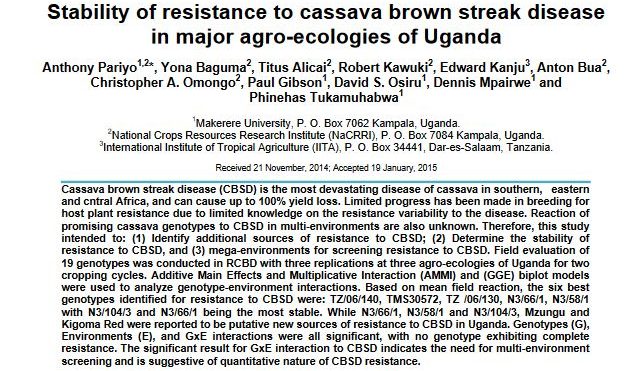Cassava brown streak disease (CBSD) is the most devastating disease of cassava in southern, eastern and central Africa, and can cause up to 100% yield loss. Limited progress has been made in breeding for host plant resistance due to limited knowledge on the resistance variability to the disease. Reaction of promising cassava genotypes to CBSD in multi-environments are also unknown. Therefore, this study intended to: (1) identify additional sources of resistance to CBSD; (2) determine the stability of resistance to CBSD; and (3) determine mega-environments for screening resistance to CBSD. Field evaluation of 19 genotypes was conducted in a randomised complete block design with three replications at three agro-ecologies of Uganda for two cropping cycles. Additive Main Effects and Multiplicative Interaction (AMMI) and (GGE) biplot models were used to analyse genotype-environment interactions. Based on mean field reaction, the six best genotypes identified for resistance to CBSD were: TZ/06/140, TMS30572, TZ /06/130, N3/66/1, N3/58/1 with N3/104/3 and N3/66/1 being the most stable. While N3/66/1, N3/58/1 and N3/104/3, Mzungu and Kigoma Red were reported to be putative new sources of resistance to CBSD in Uganda. Genotypes (G), Environments (E), and GxE interactions were all significant, with no genotype exhibiting complete resistance. The significant result for GxE interaction to CBSD indicates the need for multi-environment screening and is suggestive of the quantitative nature of CBSD resistance.
Region: Uganda
Date published:
2015
Published by:
Journal of Plant Breeding and Crop Science
Type of resource:
Journal article
Resource topic:
Cassava
Project/Programme: Not specific
Pest/Disease: CBSD
Pages:
12
File type:
External link (172 KB)




